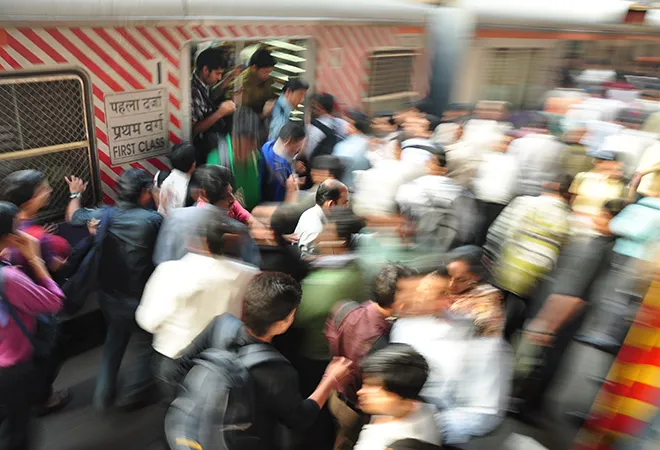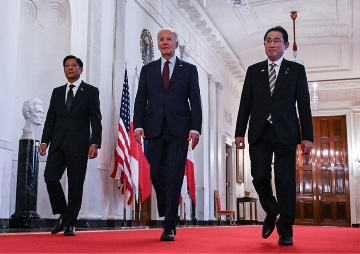
Public health crises in the past have often led to cities reinventing themselves and evaluating the obstacles urban areas pose to the containment of epidemics. London’s ‘Metropolitan Board of Works’ and mid-19th century sanitation systems developed in response to the cholera outbreak. During the 2014-2015 Ebola epidemic, urban centers of Guinea, Liberia and Sierra Leone, learned that a larger population would require more services and good coordination between all relevant sectors to manage this requirement. The bubonic plague in Bombay between 1896 and 1899 prompted discussions on providing better housing for the health of mill workers.
What fissures has COVID-19 exposed in city-planning today? How can urban planning systems equip themselves better for future pandemic management? This article will explore the relationship between the pandemic and urban density, informal settlements, social infrastructure, and defensive designing in order to provide a potential direction for urban planning.
COVID-19 and urban density
A lot of discussion surrounding the future of urban planning post-covid19 seems to suggest that the rate of spread of the virus is proportionally correlated with the density of cities. On one hand, New York City in USA, Mumbai in India, and London in the UK are all considered dense cities in their respective countries and are also hotspots for COVID-19. On the other hand, there is the case of Singapore, Seoul, and Hong Kong – dense cities that have outperformed lesser-populated places, as shows in Table 1.
Table 1: International Cities, number of cases and deaths as of 28th May 2020
As seen from Table 1, the number of cases for the population, as well as mortality rates in Singapore, Seoul, and Hong Kong are remarkably low, relative to other dense cities. The World Bank conducted a study that collected data for 284 Chinese cities based on the number of confirmed Coronavirus cases per 10,000 people, and the population density in the urban area. This study showed that cities with very high population densities such as Shanghai, Beijing, Shenzhen, Tianjin, and Zhuhai have had far fewer confirmed cases per 10,000 people. The reasoning for this is that the dense cities are wealthier and therefore have better fiscal coping strategies for the pandemic, leading to lower infection rates. In India, while dense cities of Mumbai, Delhi, Chennai, Ahmedabad, and Indore form the top 5 most affected cities, not all of the densest cities in states have the most number of cases in the state. For example, the state of Uttar Pradesh has more cases<1> in Agra (873) than Lucknow (343). In Odisha, Ganjam (394) has more cases than the denser district of Khorda (110).
Density is not necessarily a negative characteristic of urban space. A report on reshaping economic geography shows that density helps economies grow; the higher the density, the shorter the distance between workers, businesses, and parts of supply chains.
Thus, a simplistic correlation between density and the spread of the virus cannot be made. Nodal international connectivity, faulty social and physical infrastructure that does support the outbreak of a pandemic, and a lack of data and coordination amongst relevant players are the facets that have exposed certain cities to the outbreak more than they have others.
Managing informal settlements in cities
Analysis about cities affected by Ebola in West Africa showed that there was little information about the household numbers and borders of the informal settlements in dense layouts prior to the outbreak of the virus. This lack of information not only affected quarantine measures, but also testing and planning for health infrastructure to curb infection rates. Poor infrastructure and a lack of WASH (Water, Hygiene, and Sanitation) services in these settlements further deprived the residents and increased their vulnerability to the spread of the disease.
Over a billion people are currently living in informal settlements and slums in cities worldwide, without appropriate WASH facilities. An estimated 3 billion people will require adequate and affordable housing by 2030. According to a 2016 WaterAid report, India ranks first for having the highest number of urban dwellers living without a safe, private toilet. Out of 381 million people in urban areas, 157 million have no access to proper sanitation and an estimated 41 million of these have no choice but to defecate in the open.
Pandemic responses must be buttressed by an urban-planning system which includes data collection of number of people, number of households, pockets and areas of vulnerability, as well as the availability of WASH amenities. Preparedness and response plans cannot be made unless the number of people living in areas and information of civic amenities available to them is known. A focused drive to collate up-to-date disaggregated data of formal-informal settlements in cities is important in order to correctly gauge the funds that will be required to provide adequate access to food supplies, housing, sanitation, and financial services. A ready handbook of available infrastructure data is also important in order to better understand the pockets and focus of exposure during a crisis.
Unique forms of informal labour in urban areas are also going to be affected by the overall changes in workspace. Commercial cities have an ecosystem of ‘street vendors’ – Mumbai, for example, has pockets of vendors in the commercial zones of Nariman Point and Lower Parel, where hungry employees get a quick cheap meal. Reduction in office spaces and increased work from home policies in the future due to paranoia over social distancing norms will lead to a correlated reduction in such vending pockets.
Currently, India has approximately 10 million hawkers. The Street Vendors (Protection of Livelihood and Regulation of Street Vending) Act legalised the activity, where designated Temporary Vending Zones would be created in order for vendors to retain their livelihood. This sort of urban planning will need to accommodate the issues of social distancing in the future. Though some amount of informal vendors will lose jobs, safe vending zones adhering to social distancing and safety precautions can be initiated in order to mitigate widespread job-loss.
Social infrastructure in cities
A McKinsey Report on the impact of COVID on the service industry shows that while the airlines industry has grounded planes and reduced its handling and maintenance activities, its customer-care centers have been extremely busy. Similarly, while branches of physical retail banks are reducing working hours, work in the call centers is booming.
This suggests that COVID-19 will lead to a new a new form of jobs, in order to design a city life that fits social distancing norms. Helplines for health professionals, sanitation and hygiene committees for industries that depend on physical and human contact, and new nodal authorities for migrant-management in cities have already sprouted. These jobs will be essential in attempting to curb the negative impacts we have witnessed from the pandemic today.
The future of defensive designing
Defensive designing of cities has already been in vogue, as it aims to curb loitering, prevent crime and destruction of public property by designing ‘defensive infrastructure’ keeping public discomfort and inconvenience in mind. The future of such designing will include ‘social distancing’ in its reasoning, keeping public convenience in mind this time.
Awkwardly spaced armrests on park benches, short backs on street furniture, and ‘leaning bars’ can be seen across New York, while London has designs like the the ‘Camden Benches’, which are slightly slanted concrete benches. These designs may come in handy in the future, with the growing need for social distancing in public spaces in order to better handle future pandemics. However, these designs will have to go hand-in-hand with plans to accommodate the homeless populations of cities. According to the US Department of Housing and Urban Development, NYC has nearly 80,000 homeless people living in wither shelters of the street. According to the 2011 census, there are 1.77 million homeless in India of which 57,416 stay in Mumbai. If urban planners and administrative officials want public spaces to be vagrant-free, it is essential for these large numbers to be provided appropriate rehabilitation in the form of shelters with adequate amenities and provisions.
Resolution of the immense informal settlements in urban areas is a herculean task that will not be resolved immediately. Therefore, urban planning must include better data management in order to mitigate the deadliest impacts of future pandemics. This information, together with the effective coordination that dense cities can naturally provide, would be crucial in the deployment of essential services to the neediest.
<1> Coronavirus cases as of 28th May 2020
The views expressed above belong to the author(s). ORF research and analyses now available on Telegram! Click here to access our curated content — blogs, longforms and interviews.




 PREV
PREV


